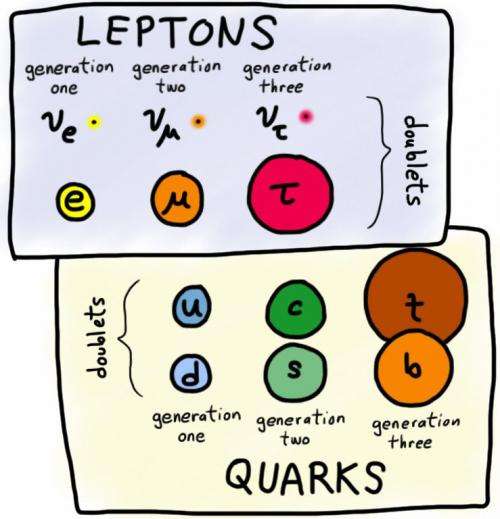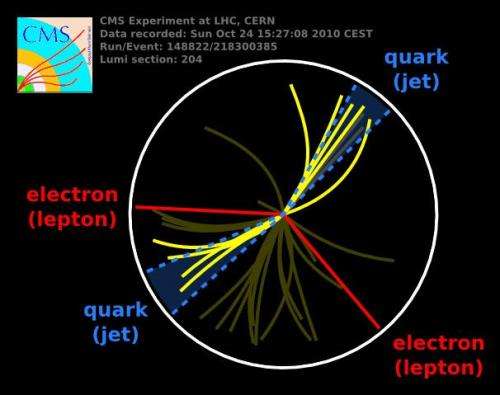Hunt for the platypus particle

All of the atoms in our bodies are made of electrons, protons and neutrons, and the protons and neutrons can be further broken down into quarks. Fundamentally, then, we are made of only two types of particles: electrons and quarks. But what do these labels mean? Why do we even say that electrons and quarks are different from each other?
Since they don't come with nametags, we have to define particles by how they interact. It is a bit like cataloguing wildlife on a new continent—at first, everything is strange, but eventually we see how the species can be grouped into patterns. Some animals quack and waddle, so we call them all ducks, while others are furry and build dams, and we choose to call them beavers. When physicists first explored the subatomic world, they noticed that there are two basic types of nuclear interactions, one much stronger than the other. To this day, they are called the weak force and the strong force because they never got better names.
Particles of matter were similarly grouped into two classes, leptons and hadrons, which come from Greek words for small and big. Curiously, leptons seem to be completely unaffected by the strong force while hadrons are utterly dominated by it. Although leptons, such as the familiar electron, can turn into other leptons—muons, taus and neutrinos—the total number of leptons in the universe appears to be constant (counting a matter lepton as plus one and an antimatter lepton as minus one). The same is independently true of quarks, the fundamental building block of hadrons. There may be a deep reason for this similarity, but it isn't yet known.

The resemblance between leptons and quarks is even more striking when we arrange them by how they interact with the weak force. Many physicists suspect that the similarity between leptons and hadrons is not an accident, and that they might be connected somehow. If so, then there could be a new particle that is a little of both—a "leptoquark". Such a thing would be as shocking as the discovery of the platypus, a mammal that lays eggs like a duck yet is furry like a beaver.
Physicists have been searching for leptoquarks for years, but have never found one. If they do exist, then they must have a higher mass than previous experiments were able to reach. Leptoquarks could also allow ordinary matter to spontaneously decay, something that has never been observed. If leptoquarks have a high mass, then fluctuations in ordinary matter would rarely reach it and decays would be too infrequent to have been noticed. Both of these considerations point to a high energy scale, so it is worth looking for leptoquarks at the LHC, the highest-energy collider in the world.
CMS searched through all of the data collected in 2011, which corresponds to about 500 trillion proton-proton collisions. They were looking for events in which a leptoquark and an anti-leptoquark were produced by the energy of the collision, each decaying into a lepton and a quark (or their antimatter equivalents). Some leptons, like the electron, leave a clean track through the CMS detector, while others, like the neutrino, are invisible to the detector and have to be inferred from an imbalance in the debris. A quark always produces a spray of particles known as a jet.
The search turned up a handful of events with these characteristics, but no more than would be expected from known physics processes. Therefore, this result sets the most stringent limits yet on the mass of leptoquarks. CMS is already hard at work examining the data collected in 2012, in which the proton-collision energy is higher and therefore capable of producing more massive leptoquarks, should they exist.
Why scour a mountain of data to search for a particle that might not exist? To paraphrase George Mallory, "Because it could be there."
Source: CERN




















